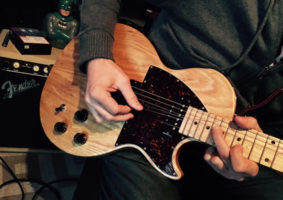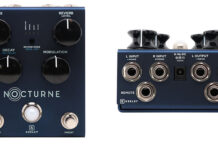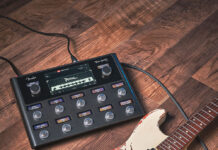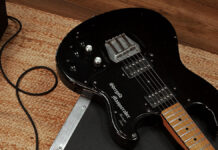
How to Devise Melodic Metal Licks for Rhythm Guitar Parts
When writing riffs, one of the greatest challenges is to create parts that are not just melodically and rhythmically effective but also memorable and powerful.
When writing riffs, one of the greatest challenges is to create parts that are not just melodically and rhythmically effective but also memorable and powerful.
The best metal riffs—like “Crazy Train,” for example—contain all of the qualities necessary for a great riff: hard-driving power, strong melody and, most importantly, a “star quality” that makes the riff instantly recognizable.
This is true for both fast and slow riffs, because a really great riff doesn’t have to be impressive exclusively in a technical sense. This month, I’d like to present a couple of riffs that I believe exemplify these qualities.
FIGURE 1 is built from a series of two- note diads, played on the D and G strings, which alternate against a steady 16th-note- driven open A-string pedal tone.
When playing this riff, I lightly palm mute the open A string by resting the edge of my pick-hand palm across the strings just beyond the bridge saddles, but I release the palm mute when striking the two-note diads so that they will be accentuated and ring out clearly.
The distinct elements that make this riff powerful and musically effective can be boiled down to the combination of the rhythmic syncopation and the melody that is implied by the highest note sounded in the figure. In bars 1-4, the “melody” note progresses down the fretboard. On the second ending, I bring in a different bass note, C, followed by an open D-string pedal tone.
The trickiest part here involves the pick hand, as you will need to quickly jump across strings as precisely as possible.
Let’s ratchet up the tempo a bit for the riff in FIGURE 2, which is built from the same basic elements. In regard to the pick hand, I stick with alternate (down-up) picking for most of the riff, once again applying palm muting on the lowest notes of the chords while lifting the palm for the accented two- note chord shapes. The second time around, I bring the open low E in as the pedal tone, so now the pick hand has a little more work to do.
Remember to pick as precisely and efficiently as possible in order to make this riff speak the way that it should.
Remember, a truly great riff will sound just as cool and heavy when played slowly as it will when played fast. That, to me, is the best way to judge the merits of a riff.

Source: www.guitarworld.com










